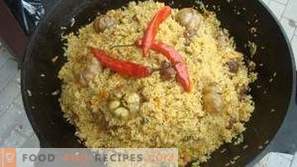
Pilaf is an oriental dish that has gained worldwide popularity. Different nations prepare it in different ways, but only one thing remains unchanged - spices and seasonings, without which it is impossible to imagine real pilaf. Without spices, it will not be pilaf, but just rice porridge with meat.
It is the spices that give the dish a unique taste, aroma and sharpness. In addition, the seasonings serve as a natural preservative, which allows the pilaf for a long time not to deteriorate in hot climates. They are responsible for burning extra calories and for quickly quenching hunger. Spices improve metabolism and digestion.
Classic spices for pilaf
Any trader on the market, especially if he comes from Central Asia, will help to choose a seasoning for pilaf, depending on your preferences - sharper, thicker or maybe painted in golden saffron.
But the three components of this oriental pilaf remain unchanged - this is zira, barberry and red pepper.
Zira is a herbaceous plant, only seeds are used to make pilaf. In order for the spice to fully reveal its slightly bitter and rich aroma, before adding seeds to the dish, you need to crush a little with a wooden mortar - you will immediately feel the amazing smell emanating from the eastern spice.
Zira will not only help to digest fatty foods better, but also prevent stomach cramps and flatulence.
Barberry - for pilaf use dried berries of this shrub. Barberry berries will give rice a little sourness. Whole berries are added to the pilaf, which, when biting, will explode with a pleasant apple flavor. Barberry will help you quickly come to the feeling of saturation. Berry is a real source of vitamin C, glucose and fructose.
Red pepper (pungent) is used in traditional Asian cuisine, while European cuisine prefers sweet paprika. You can use a mixture of peppers - it will give the pillow a piquant bitter-sweet flavor. It is advisable to grind the pepper immediately before adding to the pilaf, or add whole pods.
What other seasonings can be added to the pilaf
Saffron in pilaf is almost always added, the only reason for its absence can be a rather expensive price, which will have to be paid for spice. Saffron will give the rice an amazing golden hue, delicate aroma and a unique bitter-sweet pungent flavor that cannot be described - it needs to be tried.
Many people add garlic to pilaf, and the whole goes into the dish, and not the head that has not been passed through the press or the grater, which has been previously purified from the husk.
Professional chefs like to add dried tomatoes, bay leaves, coriander seeds, cilantro, parsley, and even Provence or Italian herbs to the pilaf. In Europe, such seasonings for pilaf as mustard, black pepper, nutmeg and cloves are popular - they all perfectly highlight the taste of roasted meat.
Such seasonings as zira, marjoram, basil, coriander and cumin are well suited for pilaf with beef.
For pilaf with chicken, in addition to the classic seasonings, you can add oregano, dried thyme and cumin seeds.
Pork pilaf can be supplemented with spices such as turmeric, dried tomato and sweet paprika.
You can even make pilaf from fish! In this case, curry and hops-suneli will work well. For fruit pilaf, which is prepared without meat, you can take a little barberry, cumin, saffron, raisins and dried fruits.
Such exotic Indian spices as curry and cardamom, cumin, fennel, tamarind and many others have become available to modern hostesses. With the help of these unusual spices, you can make the spicy hot or, on the contrary, soft, and you can also improve your mood for yourself and your loved ones from a perfectly cooked dish.
How to add seasonings to the pilaf
The main rule - do not overdo it! Spices need to be added quite a bit, so that they emphasize the taste of the dish, rather than interrupt it. The sense of proportion is decisive when adding seasonings, its absence can lead to the fact that the expected subtle taste will not be achieved, and the dish itself will be hopelessly spoiled.
All seasonings, except fresh herbs, are added not to the pilaf itself, but to the zirvac.
Zirvak is all that is cooked in a cauldron before adding rice. First, an oil is heated in a cauldron, in which meat, onions and carrots are fried - this delicious mixture is called zirvak. The rice is added to the zirvak last, along with the water.
The readiness of the zirvaka is determined by taste and visually: by the disappearance of the foam and the layer of fat that has appeared on the surface. Zirvak is the basis of pilaf, the taste of the whole dish depends on its proper preparation.
The pleasant smell of roasted meat, onions, carrots in combination with spicy spices fills the pilaf with the unique taste and aroma for which this dish is loved all over the world.























